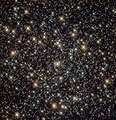NGC 3201
NGC 3201 (also known as Caldwell 79) is a low galactic latitude globular cluster in the southern constellation of Vela. It has a very low central concentration of stars.[9] This cluster was discovered by James Dunlop on May 28, 1826 and listed it in his 1827 catalogue. He described it as "a pretty large pretty bright round nebula, 4′ or 5′ diameter, very gradually condensed towards the centre, easily resolved into stars; the figure is rather irregular, and the stars are considerably scattered on the south".[10]
| NGC 3201 | |
|---|---|
 | |
| Observation data (J2000 epoch) | |
| Class | X[1] |
| Constellation | Vela |
| Right ascension | 10h 17m 36.82s[2] |
| Declination | –46° 24′ 44.9″[2] |
| Distance | 16.3 kly (5.0 kpc)[3] |
| Apparent magnitude (V) | +8.24[4] |
| Apparent dimensions (V) | 18′.2 |
| Physical characteristics | |
| Mass | 2.54×105[5] M☉ |
| Radius | 40 ly[6] |
| VHB | 14.77 |
| Metallicity | = –1.24[7] dex |
| Estimated age | 10.24 Gyr[7] |
| Other designations | GCl 15,[4] GC 2068, h 3238, Dun 445, Bennett 44, Caldwell 79,[8] Melotte 99 |
The radial velocity of this cluster is unusually high at 490 km/s, larger than any other cluster known. This corresponds to a peculiar velocity of 240 km/s. While high, this is lower than the escape velocity of the Milky Way galaxy.[10] It is located at a distance of 16,300 light years from the Sun and has an estimated 254,000 times the mass of the Sun.[3] This cluster is about 10.24 billion years old.[7]
The stellar population of this cluster is inhomogeneous, varying with distance from the core. The effective temperature of the stars shows an increase with greater distance, with the redder and cooler stars tending to be located closer to the core. As of 2010, is one of only two clusters (including Messier 4) that shows a definite inhomogeneous population.[11]
Gallery
 Astronomers discovered a black hole at the heart of NGC 3201.[12]
Astronomers discovered a black hole at the heart of NGC 3201.[12] Artist's impression of the black hole binary system in NGC 3201.[13]
Artist's impression of the black hole binary system in NGC 3201.[13] Colour-composite image of NGC 3201, obtained with the WFI instrument on the ESO/MPG 2.2-m telescope at La Silla Observatory
Colour-composite image of NGC 3201, obtained with the WFI instrument on the ESO/MPG 2.2-m telescope at La Silla Observatory
See also
References
- Shapley, Harlow; Sawyer, Helen B. (August 1927), "A Classification of Globular Clusters", Harvard College Observatory Bulletin, 849 (849): 11–14, Bibcode:1927BHarO.849...11S.
- Goldsbury, Ryan; et al. (December 2010), "The ACS Survey of Galactic Globular Clusters. X. New Determinations of Centers for 65 Clusters", The Astronomical Journal, 140 (6): 1830–1837, arXiv:1008.2755, Bibcode:2010AJ....140.1830G, doi:10.1088/0004-6256/140/6/1830.
- Paust, Nathaniel E. Q.; et al. (February 2010), "The ACS Survey of Galactic Globular Clusters. VIII. Effects of Environment on Globular Cluster Global Mass Functions", The Astronomical Journal, 139 (2): 476–491, Bibcode:2010AJ....139..476P, doi:10.1088/0004-6256/139/2/476, hdl:2152/34371.
- "NGC 3201". SIMBAD. Centre de données astronomiques de Strasbourg. Retrieved 2006-11-16.
- Boyles, J.; et al. (November 2011), "Young Radio Pulsars in Galactic Globular Clusters", The Astrophysical Journal, 742 (1): 51, arXiv:1108.4402, Bibcode:2011ApJ...742...51B, doi:10.1088/0004-637X/742/1/51.
- distance × sin( diameter_angle / 2 ) = 40 ly. radius
- Forbes, Duncan A.; Bridges, Terry (May 2010), "Accreted versus in situ Milky Way globular clusters", Monthly Notices of the Royal Astronomical Society, 404 (3): 1203–1214, arXiv:1001.4289, Bibcode:2010MNRAS.404.1203F, doi:10.1111/j.1365-2966.2010.16373.x.
- "NGC 3201", Deep Sky Observer's Companion, retrieved 2012-04-28.
- Webb, N. A.; Wheatley, P. J.; Barret, D. (2005), "XMM-Newton X-ray and optical observations of the globular clusters M 55 and NGC 3201", Astronomy & Astrophysics, 445: 155–165, arXiv:astro-ph/0509085, Bibcode:2005yCat..34450155W, doi:10.1051/0004-6361:20053010.
- O'Meara, Stephen James (2002), The Caldwell Objects, Deep-Sky Companions, Cambridge University Press, pp. 314–315, ISBN 978-0521827966.
- Kravtsov, V.; et al. (March 2010), "Evidence of the inhomogeneity of the stellar population in the differentially reddened globular cluster NGC 3201", Astronomy and Astrophysics, 512: L6, arXiv:1004.5583, Bibcode:2010A&A...512L...6K, doi:10.1051/0004-6361/200913749.
- "Standout stars". www.spacetelescope.org. Retrieved 22 January 2018.
- "Odd Behaviour of Star Reveals Lonely Black Hole Hiding in Giant Star Cluster". www.eso.org. Retrieved 18 January 2018.
External links
| Wikimedia Commons has media related to NGC 3201. |
- Globular Cluster NGC 3201 at SEDS pages
- NGC 3201 on WikiSky: DSS2, SDSS, GALEX, IRAS, Hydrogen α, X-Ray, Astrophoto, Sky Map, Articles and images
- NGC 3201 at DOCdb (Deep Sky Observer's Companion)